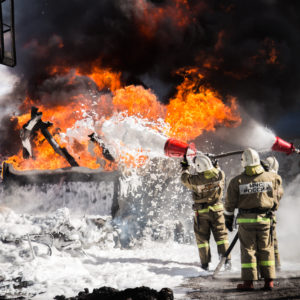Firefighter Files Lawsuit Over Kidney Cancer, Prostate Cancer Diagnosis Caused By AFFF Foam

A Florida firefighter indicates he developed kidney and prostate cancer after being regularly exposed to aqueous film-forming foams (AFFFs) used to fight fires, which contained toxic chemicals known to build up in the body and cause several health risks.
The complaint (PDF) was filed by Joseph Attanasio in the U.S. District Court for the District of South Carolina on on July 1, naming dozens of safety equipment and chemical manufacturers as defendants, indicating they all contributed to the use, spread, exposure and lack of warning regarding the presence of per- and polyfluoroalkyl substances (PFAS) in firefighter foams.
Attanasio indicates he regularly used the toxic AFFF foam both while fighting fires, and during firefighter training exercises, alleging he was never warned to take extra precautions against exposure.

Learn More About
Exposure to firefighting foam chemicals may result in an increased risk of cancer for firefighters, military and airport personnel.
Learn More About this Lawsuit SEE IF YOU QUALIFY FOR COMPENSATION“The Plaintiff was never informed that this product was inherently dangerous,” the lawsuit states. “Nor was the Plaintiff warned about the known health risks associated with this product.”
According to the lawsuit, Attanasio was never given adequate protective gear to prevent exposure to the PFAS chemicals in the firefighter foam, ultimately resulting in a kidney cancer and prostate cancer diagnosis.
PFAS were first introduced into the manufacturing industry in the 1940’s, because of their ability to resist heat, grease, stains, and water. However, since then the chemicals have been linked to a myriad of adverse health effects including liver damage, thyroid disease, decreased fertility, high cholesterol, obesity, hormone suppression, and cancer.
Experts indicate PFAS chemicals contained in the firefighter foam can take thousands of years to degrade, and past studies have highlighted their ability to enter and stay in the environment and human body through the air, dust, food, soil, and water.
Attanasio’s complaint joins a growing number of AFFF foam cancer lawsuits filed nationwide by former service members, civilian firefighters and residents living near military bases or chemical plants, all involving claims that cancer and other ailments were caused by exposure to PFAS from the firefighter foam.
Given common questions of fact and law raised in the cases, the federal litigation is centralized in the U.S. District Court for the District of South Carolina, where it is expected that a small group of “bellwether” cases will be prepared for early trial dates, to help the parties gauge how juries respond to certain evidence and testimony that will be repeated throughout the claims. However, if settlements or another resolution for the lawsuits is not reached following coordinated pretrial proceedings, hundreds of individual claims brought by firefighters and others may later be remanded to U.S. District Courts nationwide for separate jury trials.
Get more articles like this sent directly to your inbox.
"*" indicates required fields






0 Comments